#age of sail replica
Text
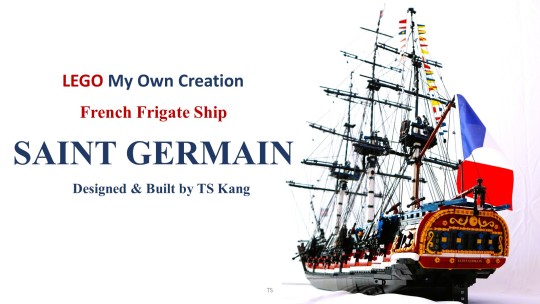


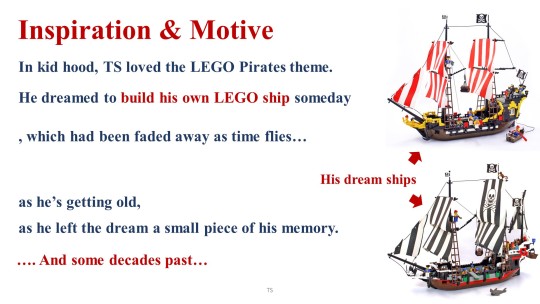


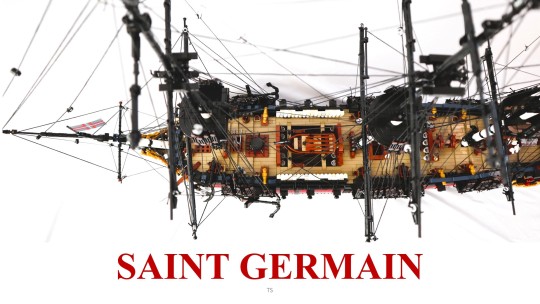
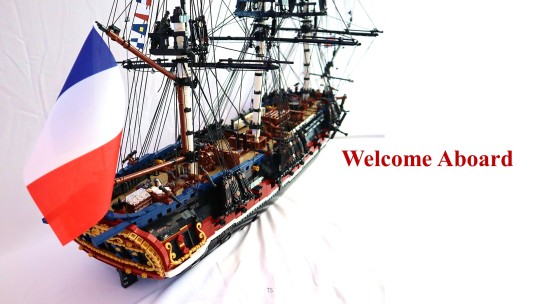


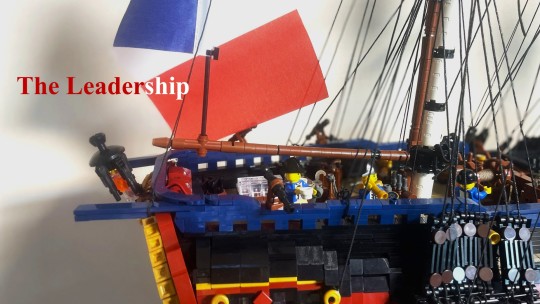
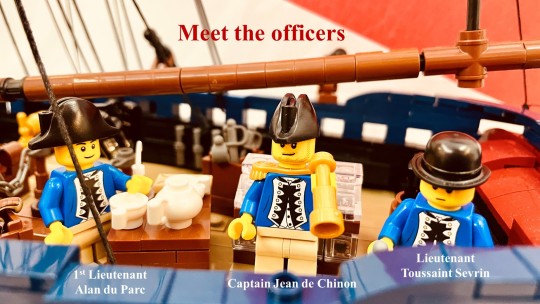

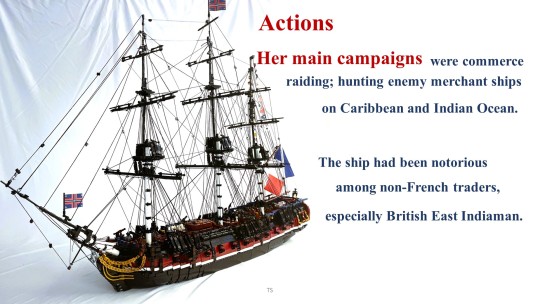


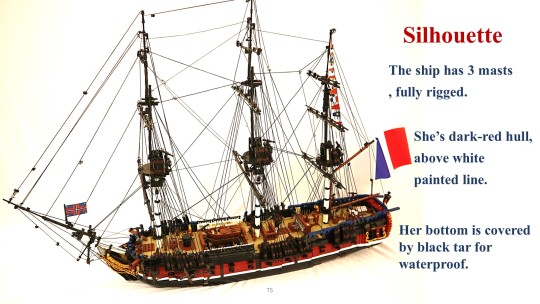


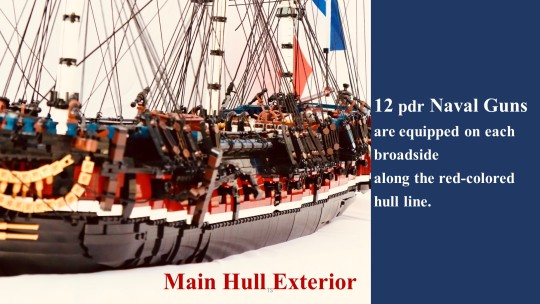




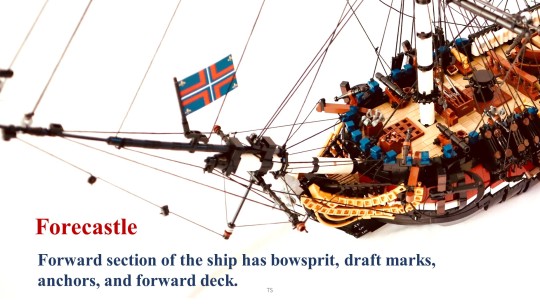



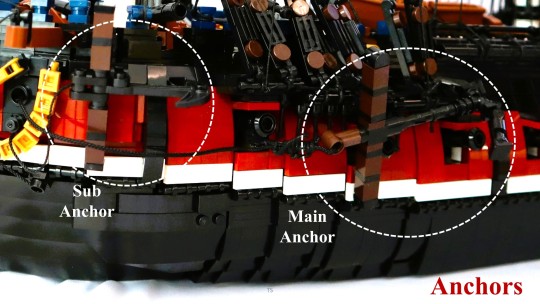
Lego MOC ship
French Frigate "Saint Germain" - PART 1
designed by TS Kang
Instagram - @art_house_colts
Youtube - https://www.youtube.com/watch?v=wjFyaucj5Xk
#navy#aubrey maturin#sailing ship#tall ship#jack aubrey#pirate ship#lego moc#lego builds#lego art#lego photography#saint germain#psg#minifigures#lego ship#legoship#frigate#age of sail replica#mid 19th century#naval art#age of sail#maritime#the sea#sailing frigate#sailing#boats#sailboat#sea#corvette#master and commander#lego
9 notes
·
View notes
Text

112 notes
·
View notes
Text
Replica ship of Jeanie Johnston
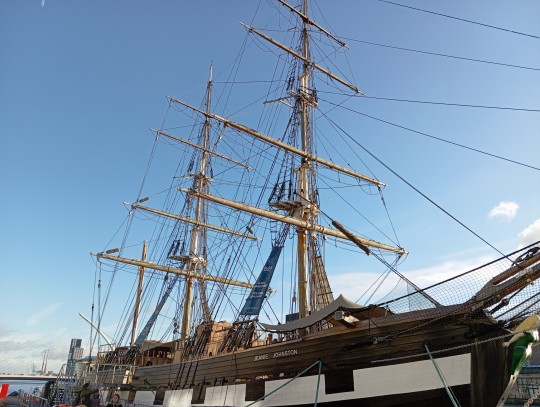
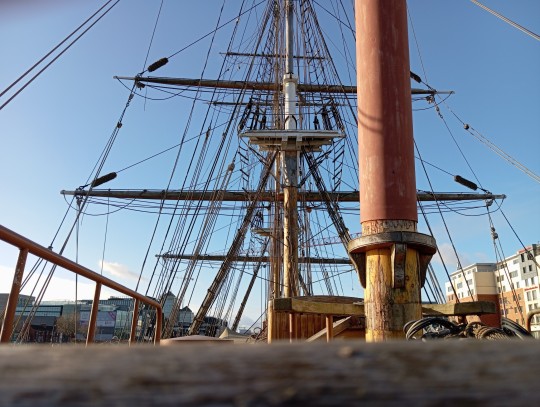
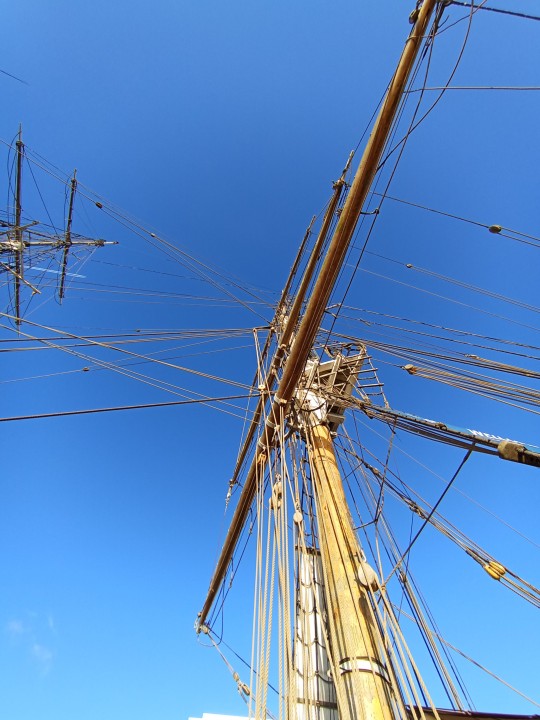
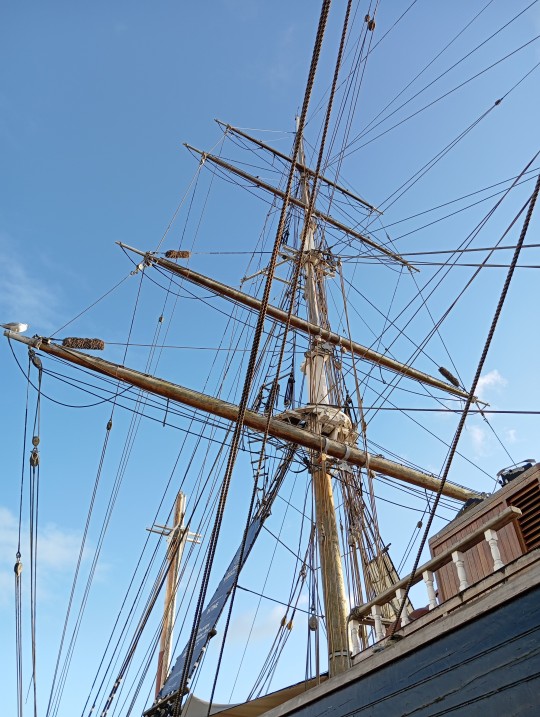



#jeanie Johnston#replica ship#barque#Ireland history#history#ireland#age of sail#of mice and me#my photos
124 notes
·
View notes
Text

Pride of Baltimore II, photographed by Norbert Stager.
#tall ship#war of 1812#replica baltimore clipper#pride of baltimore ii#15 star 15 stripe us flag!#age of sail#age of fighting sail#the sea#baltimore clipper
78 notes
·
View notes
Text
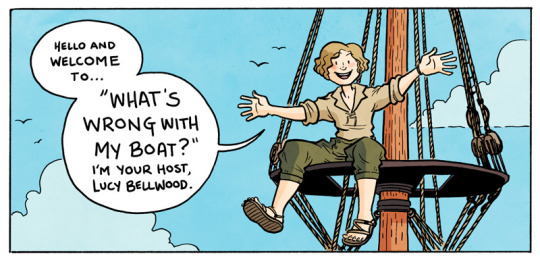
I’ve been meaning to repost this mini-essay I wrote for Global Maritime History back in 2015 for AGES and since today's dash is full of people lamenting the burden of Boat Knowledge this seems like the right time.
ONWARD FOR TALL SHIP ART TIPS!
I often get questions from people who are concerned that their illustrated boats aren’t going to be up to snuff, and the short answer is generally: don’t sweat it. If you’ve drawn a thing that has a hull in the water and sails in the air, you’re off to a great start, and if you consult a few handy reference images, you’re bound to end up with something that looks mostly ship-like.

HOWEVER. There are a couple things that often get lost in translation which—if you pay attention to them—can make the difference between a passable tall ship and a vessel that definitely looks like you know your baggywrinkle from your bunghole. Here’s two tips to get you started.
Flags in the Wind
Generally when we think of a thing that’s going fast, we imagine a flag streaming out in the wind behind it, right? Well, when it comes to square rig sailing, things aren’t always so simple. If the wind is coming up from behind a ship—or from the side—to push it forward, the flag may be flying in a direction you wouldn’t expect! How are the yards angled to catch the wind in the sails? What’s driving the vessel forward? Sailors often look to flags for a quick indicator of wind direction—use that thought process when drawing your ships.

Keep Your Shrouds Tight!
Those rope ladder-looking things sailors are always clambering up? They’re called shrouds, and they also form a large part of the tensioning system that keeps a ship’s masts stable and upright. Stays (lines that don’t move i.e. stay put) are arranged throughout the rig to maintain even aft-to-fore pull on the masts and prevent them from keeling over. Shrouds form the lateral component of that system, so here’s an important fact: they will not be saggy. No saggy shrouds. No saggy stays. In addition to making the mast unstable, it’d be a devil to climb in heavy weather.
Note: the ratlines (the “ladder rungs” of the shroud) can have slack in them—it’s the vertical lines that should be tight.
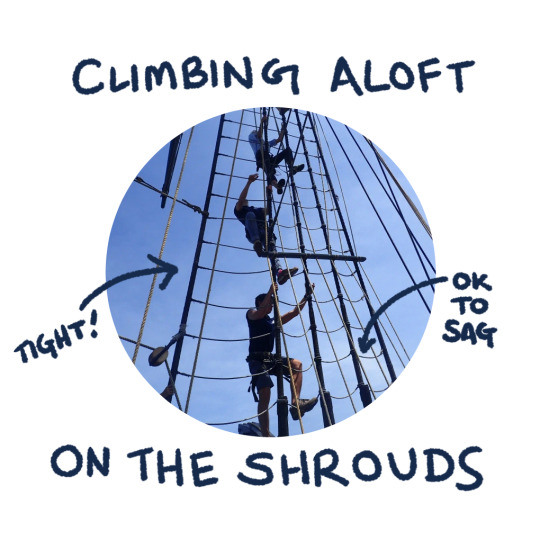
When the crew is “tuning the rig,” they’re putting slack in all the stays and then re-tensioning them to ensure that the whole operation is as stable as possible, so unless you’ve got a bunch of idiots running your fictional vessel, keep ’em tight.
And another thing…
I see a lot of people running their shrouds down to the deck, rather than alongside the vessel. Don’t do that! I mean, okay, sometimes shrouds do attach to chain plates on-deck, but most of your classic Golden Age of Sail vessels will have them running alongside to the channels. Also: they end in deadeyes to help with the tensioning of the line and to keep things stable, so don’t forget your deadeyes!

Honestly, these are the biggest things that I see artists flub when drawing tall ships, so if you can keep them in mind, you’ll be head and shoulders above the rest!
If you’re looking to go more in-depth with your research, I would recommend…
Seeing if you can find a modern replica of the type of ship you’re after and then centering your reference search around the name of that ship. I get far more extensive results when I’m searching for “Privateer Lynx” rather than “1700s topsail schooner.” Don’t discount the many photos tourists will have taken while visiting these ships!
Nose around on model ship-building forums. There is no greater boon to the modern nautical artist than these obsessive craftspeople, who will spend hundreds of hours replicating classic ships in minute detail—often photographing the whole process so you can actually see how the rig of a vessel is put together! God bless ’em.
And that’s all I’ve got! I hope you’ve enjoyed this brief foray into accurate tall ship representation. Fair winds and following seas!
#tall ships#boat stuff#maritime history#tall ship#maritime art#lucy bellwood#art tips#age of sail#personal work
962 notes
·
View notes
Note
Are you still doing that viking time travel au?

Part One: Bodies
One: You are Here.
Two: Here.
Author's Note: I am! So there's science I kind of completely bullshit because I just kind of stole the language from some studies I'm familiar with and probably a very shitty replica of how the British actually store archaeological material but I got so caught up in details I couldn't get it finished so it's thoroughly bullshit! The burial is based on the Repton Warrior, adjusted for fictional use ofc.
Archival Description of Burial A452 and A453 of Red Sail Hall Site
School of Archaeology - University of Oxford
Research Laboratory for Archaeology and the History of Art
Though further exploration into the site is certainly precluded by the sealing of the original site by the private owners, the four-month trial period of archaeological work on property associated with Red Sail Hall has proven themselves to be incredibly fruitful. Please review the following in-situ finds of particular significance. Of a group of 34 burials immediately south of the gardens of Red Sail Hall, the burial of an adolescent male, an extraordinary 187 centimeters is of special note. In an abutting grave was a second male inhumation, was found that of a child perhaps aged 12 standing at 134 centimeters.
The elder male was a person of obvious importance, apparently having met his end in battle or some other violent means. Likely incapacitated by a blow to the head as suggested by lacerations to the skull, the elder was then dispatched by sword cut. When measured, the damage to the vertebrae suggests the femoral artery would have most certainly been severed. The burial is in truly pagan fashion. On a silver ring around his neck was a silver Thor’s hammer between two red glass beads. A leather belt around the waist had been secured with a belt and bronze buckle with a fleece lined iron scabbard with an impressive tri-bloom pommel in classic Norse fashion. By the sword hilt there was a folding iron knife, a fixed knife with a wooden handle and halfway down the thigh was found three iron keys.
The skeleton in the abutting grave was tentatively Christian and of much poorer origin. A lead figure on a leather cord around the neck suggests Anglo-Saxon Christianity. An iron seax at the waist was of Cumbrian origin but the iron fittings of a leather quiver with bow and arrows inside found deposited at the left hand were of clearly Welsh origin. No other grave goods were found, but pollen deposites would suggest the presence of Michaelmas Daisies and Autumnal Crocus, suggesting a harvest-time burial.
Would recommend both graves for sampling and dental isotope analysis. Low-humidity storage recommended.
National Institute of Water and Atmospheric Research
Oxygen Isotopes Conclusive Report of Paired Samples A452 and A453
Red Sail Hall Sample A452
Based on a framework of radiocarbon dates, the studied inhumation grave of Red Sail Hall Sample A452 upon analysis of radiocarbon determination and isotope ratio mass spectroscopy reveal an observed dietary variation of game protein intake with high amounts cereal grains primarily wheat. Noted markers of deprivation at aged 15-16 are seen. This finding is consistent with an origin of the Danish mainland of the 150-50 BCE.
Red Sail HAll Sample 453
Sample of nebulous value. Sample noted to be from a child with pre-adolescent degrading of sample in-situ. Whilst there is no clear pattern of isotopic offsets between skeletal elements, the sole first molar analyzed shows a high degree of isotopic enrichment for both δ13C and δ15N. As the first molar forms during infancy, a conclusion of high status, high protein diet can be drawn. The second sample however, suggests marked poverty and high cereal and plant based diet. This finding is consistent with an incongruous origin of the samples labeling suggesting instead the British Isles, most likely Cumbria, 1st Century CE
Conclusion signed and certified by Aroha Kaipo, National Institute of Water and Atmospheric Research Isometric Laboratory, New Zealand.
Red Sail Hall, 21st Century
“I’m not entertaining the possibility because it’s not possible.” Arthur snapped, pacing about the kitchen. Rhys dragged his hand down his face.
“How many times do we have to go over this? Zee did the results herself!”
“Once more, I bloody suppose because I am standing right here!”
“I’m not saying I know how, I’m just saying its you. And Magnus.”
“It’s horse shit!”
“Arthur!” Rhys pressed him into a chair by the shoulders. He was practically vibrating with agitation. His leg started bouncing.
“I am not a figment of my own imagination! I’m just here!”
“Yes, you are.”
“They can’t have drug up my corpse from the back garden when I am standing right here!”
“And yet they have.”
#hws denmark#hws wales#hws england#my writing || cacoethes scribendi#Magnus || climb the roots of Yggdrasil#Rhys || my word for heaven was not yours#Arthur || stone set in the silver sea#the dangeld axe to grind: the viking age time travel au#The Viking Age || the children of wind and wolves
103 notes
·
View notes
Text
My One Piece OCs Part. 1
Since @supermarine-silvally and I became excellent friends, I thought I would share my One Piece OCs with them. I'm unsure when I would post pictures of them because I'm still learning to draw.
The way I came up with my OCs is weird. I had totally different ideas for them until one day, while working on earth science homework, a sudden idea came to me: "What if Little Red Riding Hood was a pirate in One Piece? And what if she was shipped with Portgas D. Ace in the Survivor AU?"
So, I revamped my MC OC so she could be what TV Tropes called a Red Riding Hood Replica. Of course, I couldn't just stop with Little Red. No, I had a fairy tale theme going on! I had to add Goldilocks and some others you might recognize.
I never thought I would get into One Piece, let alone make fairy tale-based One Piece OCs, but here I am, LOL. Anyway, this post is long and will contain some spoilers for anyone who are on the East Blue Saga. So read at your own risk.
I plan to write fanfics about these characters after I flesh them out (and the story) but feel free to ask me or some of my OCs some questions.
Right now, I just want to post my main ones. I hope you like ‘em, especially you Hadley!
Edit 4/22/2024: I just had to touch up some things and change the name of Blanchette's mother. I see her as more as a Sylvia than a Helene.
"Red Hood" Delahaye Blanchette

DOB: August 10, 1501 (World Lion Day) | Gender: Female | Age: 21 (pre-timeskip) / 23 (post-timeskip) | Devil Fruit: Neko Neko no Mi, Model: Manticore | A Brass Knuckles-wielding Combatant of the Spade Pirates and, subsequently, the Whitebeard Pirates | Voiceclaims: Megumi Hayashibara (Japanese), Laura Bailey (English, Funimation)
Blanchette's surname was taken from my favorite pirate Jacquotte Delahaye, while I got her first name from Charles Marelle's rendition of the fairy tale "The True History of Little Goldenhood". In that fairy tale, Charles gives Little Red Riding Hood a real name–Blanchette.
Blanchette was born in Porto, a pirate haven that was the capital city of Rara Island. She was the result of a fling between Delahaye Sylvia and Crocodile, who stayed in Porto for a few months shortly after watching Roger's execution. Crocodile left before Blanchette was born, leaving her to be raised by Sylvia. She didn't know who her father was until she was six. Sylvia explained that Crocodile left to pursue his ambitions. Needless to say, that would cause Blanchette to resent her father.
As her mother worked several jobs to support them, Blanchette spent a lot of time with her grandmother, Maria, who told her stories about her adventures as a pirate. These stories captivated Blanchette so much that she was inspired to become a pirate when she was older. Blanchette engaged in mischief on the streets like many other kids in Porto did but didn't have many friends, as her peers would either avoid her or make fun of her for having a dark blue-gray pigment around her right eye known as Nevus of Ota. One time, she was about to fight a girl who called her 'Black Eye' but was stopped by another girl named Aurelia, who would become her best friend and later sister (they are sisters in the same way Ace, Sabo, and Luffy are brothers).
Discovering that they shared dreams of becoming pirates, Blanchette and Aurelia would steal money and other needed resources when they set sail together. This is how Blanchette got her Devil Fruit powers, stealing what she thought was an ordinary pineapple because she was hungry. The two sisters would borrow money from hustlers willing to bet on anything, from throwing a rock the farthest to fighting other kids.
When she turned 15, Blanchette began participating in underground street fights to help support her mother. Due to her skills with brass knuckles and Devil Fruit powers, she quickly rose to become a renowned street fighter. Some pirate captains who witnessed her fights even wanted her to join their crew, but she would turn them down because she would rather start her own pirate crew than join someone else’s.
One day, Blanchette was coming home from a match. She headed to Maria's house to give her some flowers she had bought as a surprise gift. On her way, she met a wolf mink pirate named Grimm, who tried to convince her to join his crew, the Cutthroat Pirates. When she declined, Grimm told Blanchette she'd missed an opportunity but respected her decision and walked away to meet his crew.
Once she reached Maria's house, Blanchette entered inside only to find her grandmother lying on the floor, bleeding heavily from her wounds. She tries to get some help, but Maria advises her not to as she'll be dead by the time help arrives. She manages to tell Blanchette that the man who killed her was Grimm. Since that tragic day, Blanchette has been rigorously training herself to be strong enough to take down the Cutthroat Pirates.
At 18, Blanchette would join the Spade Pirates three months after Helene died of an illness. Although she had planned to start her own pirate crew, she was so charmed by Ace that she decided to accept his offer to join his crew (It helps that Ace wanted to help Blanchette get her revenge on the Cutthroat Pirates). Little did Blanchette know, she was going to be in for one hell of a ride with this crew lol.
"Goldilocks" O'Malley Aurelia
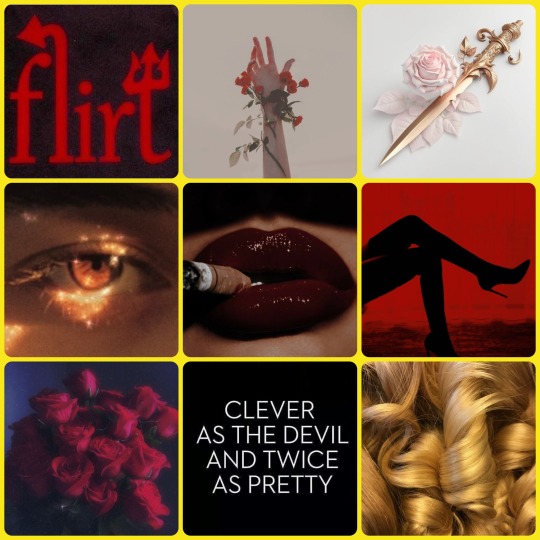
DOB: May 6, 1500 | Gender: Female | Age: 22 (pre-timeskip) / 24 (post-timeskip) | Devil Fruit: Rozu Rozu no Mi | A Swordswoman of the Spade Pirates and, subsequently, the Whitebeard Pirates | Voiceclaims: Kikuko Inoue (Japanese), Cherami Leigh (English, Funimation)
Blanchette’s older sworn sister, Aurelia. Her surname was taken from the Irish pirate Gráinne O’Malley. Her first name is a Latin female name that means golden, fitting for a character loosely based on Goldilocks.
Aurelia was born somewhere in the South Blue to pirates but spent most of her formative years on a pirate ship. Her parents were starting to see see her as a burden, so they decided to abandon her in the East Blue in Rare’s capital city when she was only 7, lying that they would pick her up later. After spending a long time in the city, Aurelia realized that her parents were never coming back.
She began living on the busy streets of Porto, stealing food and other resources needed to survive. She even attempted to rob others, which came with mixed results. At some point, Aurelia befriended another girl named Blanchette, whom she persuaded to not beat up her bully. They would become the best friends, hanging out and getting into all sorts of trouble like the little delinquents they were.
When Aurelia was 11, she came across a cottage. She looked through the windows and seeing that no one was there, she went inside to check for any food. To her delight, she found three bowls of her favorite porridge. She tasted the largest bowl, which was too hot, then the medium bowl, which was too cold. Finally, she tried the third, which was just the right temperature, and finished it all. Afterward, she searched the fridge for more food and found a strange red apple. Remembering the saying that beggars can't be choosers, she ate it without realizing it was a Devil Fruit.
Feeling rather tired, she decides to head upstairs to the bed chambers. She tries to lie down on all three beds. The first bed felt too hard, the second bed was too soft, but the third bed was just right, so she slept in that one.
However, a family of three lived in this house. When they returned from their walk, they discovered someone had eaten their porridge and the Devil Fruit they intended to sell. They went upstairs and saw Aurelia sleeping in one of their beds. Aurelia is awakened by a boy her age, Orsino Leo, who asks why she ate lunch. Aurelia explains that she was desperate and hadn’t eaten anything in a few days. When Mr. Orsino asked where her parents were, Aurelia told them they had abandoned her four years ago. Taking pity on the poor girl, Mr. and Mrs. Orsino decided to adopt Aurelia as their own.
Everything was going well for Aurelia, as she finally had a home and a family that would take care of her. As she got older, however, she started to feel overshadowed by Leo, who was gifted in the arts. This drove a wedge between her and Leo, as Aurelia felt her new parents loved Leo more than her.
At 19, Aurelia would join the Spade Pirates alongside Blanchette. She saw it as a chance to make her parents proud by becoming the richest pirates in the world. Her dream is to accumulate enough treasure that she can sell it for money and use her earnings to provide for her family.
#one piece#one piece oc#oc moodboard#oc: delahaye blanchette#oc: o'malley aurelia#tw death of a family member#tw abandonment#i hope these backstories are okay#i was actually nervous to post this#I just want to let everyone to know#I chose Laura Bailey as Blanchette’s voiceclaim because she is married to Travis Willingham#Travis Willingham voices Ace in the Funimation dub
14 notes
·
View notes
Text
Forget 'Walking The Plank.' Pirate Portrayals—From Blackbeard to Captain Kidd—Are More Fantasy Than Fact.
How we think famous swashbucklers walked, talked, and dressed didn't come from the history books, so where did these pirate myths come from?
— By Jamie L. H. Goodall
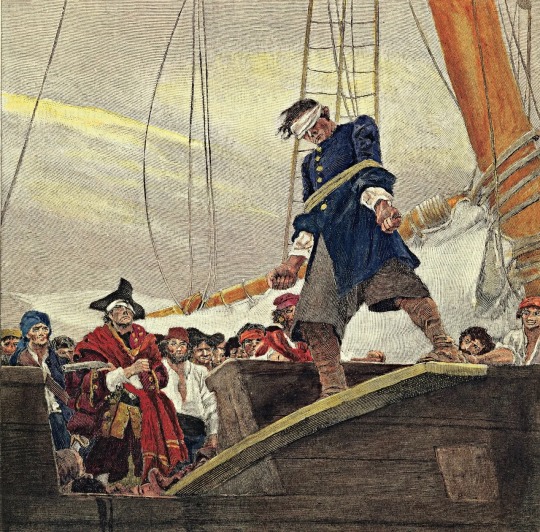
An illustration from 19th-century artist Howard Pyle depicts a man being forced to walk the plank. Although there is no record of this type of punishment, it remains popular in pirate mythology. Photograph By Image Courtesy of Bridgeman Images
Say “pirate,” and people envision grizzled men with eye patches, parrots, and treasure maps. They picture buccaneers forcing their victims to walk the plank, and crying “Shiver me timbers” as they fly the Jolly Roger flag. It turns out, many of these stereotypes are not true. Pirates have been around for nearly as long as people have sailed the world’s waters, and, in fact, still exist. It’s just how they’ve been depicted that’s often misleading. So where did these misinterpretations come from?

A replica pirate ship cruising the Caribbean Sea near the Dominican Republic. Photograph By Thomas Grau, Alamy Stock Photo
Pirate Fashion
Pirates are commonly portrayed wearing colourful attire. He may sport as a loose-fitting shirt with a bandana around his head, a scarf around his waist, ripped pants, wearing tattered boots, like Captain Jack Sparrow from the Pirates of the Caribbean film series. Or he may appear a bit foppish, much like Stede Bonnet, the "gentleman pirate" in the 2022 series Our Flag Means Death.
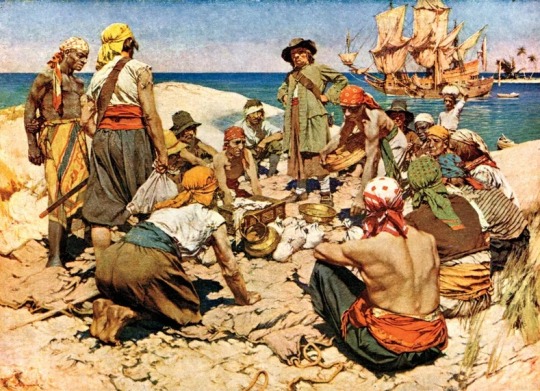
Common pop culture depictions of pirate garb, as shown here in this early 20th century artwork, are often based on fanciful descriptions of their attire and language. Photograph By Image Courtesy of Bridgeman Images
Unfortunately, these looks are just not true. Much of this ostentation came from American artist Howard Pyle, who took his inspiration from Spanish bandits of the late 19th century. Sailors in the 18th century, pirates included, wore things such as loose pants cut off at the knee and thigh-length blouses.
Prosthetic limbs are another common pirate trait. It’s true some pirates had a wooden leg or hook hand, though it probably wasn’t the norm. More often than not, amputations at sea were likely a death sentence. While ships carried medicine chests, and medical care was often meted out by someone on the crew, infection and blood loss could lead to death. Even if a pirate survived an amputation, his ability to fight would be limited. But losing a limb didn’t mean one could not continue on the ship; the person might serve the crew, for instance, as a cook.
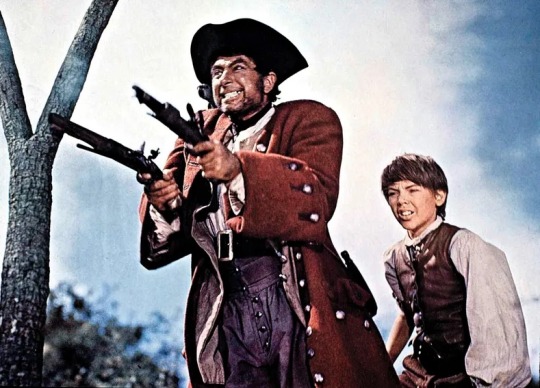
Many pirate clichés stem from the 1950 film 'Treasure Island,' featuring Robert Newton as the fictional pirate Long John Silver. Photograph By United Archives GMBH, Alamy Stock Photo
Pirate Talk
Common pirate phrases—such as Arrrrr me mateys!” and “Shiver me timbers!”—are common in pirate movies and pop culture. But they’re not legitimate things a pirate would actually have said. Robert Louis Stevenson imagined some of them for his 1883 novel Treasure Island, published more than 150 years after the “golden age” of piracy.
The trope of talking like a pirate is mostly a product of 20th-century Hollywood. In particular, British actor Robert Newton, who played both Blackbeard and Long John Silver. His portrayal of the fictional captain in the 1950s rendition of Treasure Island used an exaggeration of his own West Country accent and would define the sound of a pirate's accent. His portrayal also popularised many of the sayings associated with pirates today. In reality, pirates most probably spoke in a manner similar to all sailors of the time.
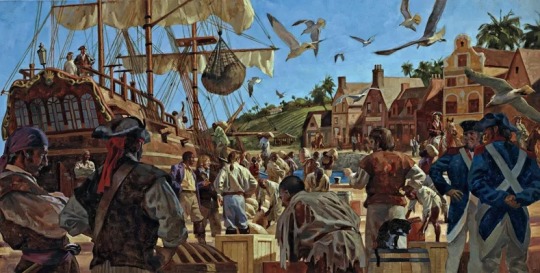
An artist imagines the often-willing markets pirates found throughout the Atlantic world for their stolen loot. Transatlantic trade was critical for the success of European colonies. Photograph By Gregory Manchess
Treasure, Buried or Otherwise
Captain Kidd may have buried his treasure, but that was a rare exception for most pirates. Typically, they spent their ill-gotten gains on women and alcohol at pirate-friendly ports as quickly as they could. Burying treasure would be dangerous due to shifting sands and tides, so one might easily lose their treasure. And there was a distinct lack of trust, not knowing if others might deceptively go back to dig up the treasure on their own.
Also, much of the loot pirates collected was not in the form of silver or gold. Such treasure would have been difficult to come by. The more common "booty" would have been whatever goods or commodities they could get their hands on, including timber, furs, silks, cotton, spices, and medical supplies. They also loaded up on items to perform necessary repairs on their ships, including cable, rigging, and sails.

Top Left: A gold bar and coins recovered from the Spanish galleon 'Las Maravillas' that wrecked in 1656 near the Bahamas. Photograph By Jeff Rotman, Nature Picture Library, Alamy Stock Photo Top Right: Prized Spanish coins, or pieces of eight, recovered from the wreck of the 'Whydah Gally'. Photograph By Zuma Press Inc., Alamy Stock Photo Bottom: Wooden treasure chests were typically studded with metal to reinforce them. Photograph By Andyroland, IStock, Getty Images
Pirate Codes
There is evidence that many pirate crews adopted a code of honour or articles of agreement, mostly to keep order on board the ship. These codes dealt with everything from how to divvy up loot, to what happened to pirates if they became injured in the line of duty, to how bad behaviour would be dealt with, to how prisoners would be treated. Some pirate articles have survived to this day, including the code of Englishman George Lowther and his crew, which, for example, compensated a person who lost a limb during a skirmish.

The 1724 articles of Captain John Phillips of the 'Revenge' discuss matters such as theft on board the ship and compensation for limbs lost during battle. Photograph By British Library Board. All Rights Reserved, Bridgeman Images
If a pirate violated the code, it is unlikely they were made to "walk the plank." Little to no historical evidence exists to support that practice, which was largely pulled from fiction, including Treasure Island. If victims were punished in some way, it was typically via keelhauling. Keelhauling was arguably a more hideous fate that involved an individual being tied to a rope and dragged under the ship. Victims of keelhauling either died by bleeding out from injuries inflicted by barnacles on the hull of the ship or by drowning. Other forms of punishment ranged from being thrown overboard to being lashed to being marooned on a desert isle.
Pirate Ships 🛳️ 🚢
Most pirates did not sail Spanish galleons, or even the frigates such as Captain Jack Sparrow’s Black Pearl. They favoured small, more manoeuvrable vessels, which allowed easy escape from larger warships that chased them. During the 16th and 17th centuries, sloops were the most common choice for pirates. They were quick and had a shallow draft, making easier escape into shallow waters. Schooners were another favourite of pirates. Similar to sloops, schooners were fast, simple to manoeuvre, and could easily hide in estuaries because of their shallow draft.

Top: A replica of the 17th-century Spanish galleon 'Neptune'. Photograph By Volodymyr Dvornyk, Shutterstock Middle: A crew raises the anchor from what is believed to be the remains of the pirate Blackbeard’s flagship, 'Queen Anne’s Revenge.' It was discovered in Beaufort Inlet, in Carteret County, North Carolina. Photograph By AP Photo, Robert Willett, The News & Observer
Bottom Left: The National Museum of the Royal Navy in Hampshire, England, displays a Jolly Roger that once belonged to Admiral Richard Curry, who seized it from pirates off the North African coast in 1790. Photograph By Andrew Matthews, Getty Images Bottom Right: Coves, such as this one near Bridgetown, Barbados, would have made perfect hideouts for pirates. Photograph By Fabio Mauri, Eyeem, Getty Images
And, despite popular myth, most pirates did not fly the famous Jolly Roger—a skull and crossbones symbol on a black flag. Some flew a black flag, which meant the pirate was willing to give quarter, while a red flag meant blood and certain death. Blackbeard’s flag showed a skeleton holding a spear pointing at a bleeding heart. Pirate crews also often held the flags of several different nations so they could raise a particular flag to signal being “friendly” to a passing ship, only to raise their pirate flag once they were in close enough range to attack said vessel.
Pirate Fights
One thing that most of the pop culture depictions of pirates got somewhat right is that they liked versatile weapons. Cutlasses, short swords with a slightly curved blade, could be used to effectively fight in the confined areas of a ship and could also be used to butcher meat.

Top: Bar shot were common tools for pirates, who used them at close range to destroy the rigging and sails of enemy ships. Due to the weights on either end of the bars, they would spin uncontrollably after being fired from a cannon. Bottom: This musket’s barrel and stock were cut down, likely so a pirate could more easily use it in close combat. Photographs By Kenneth Garrett
Pirates also enjoyed using a gun known as a blunderbuss. It had a distinct flared muzzle that sprayed small lead balls at intended victims. Cannons were also common onboard pirate ships. They could be loaded with chain shot (two cannonballs chained together), grapeshot (small cannonballs), or basic cannonballs. Their targets often didn’t stand a chance.
While books, movies, and popular culture may have taken liberty with descriptions of pirates through the ages, these pillagers have terrorised the seas for more than 2,000 years in one form or another, plundering victims and striking fear into their hearts. The most recent pirates work off the coasts of Somalia and Malaysia, looking far different from the “golden age” of piracy depictions. But one thing remains true: They are just as intimidating.

The 18th-century painting 'Anne Bonny, Female Pirate' by Fortunino Matania depicts Anne Bonny and an accomplice taking two sailors prisoner. Photograph By Image Courtesy of Historia, Shutterstock
#Culture | History#Pirate Portrayals#Blackbeard | Captain Kidd#Fantasy | Fact#Pirate Mythology#Pirate Ship 🛳️ 🚢#Pirate Garb#Fanciful | Descriptions#Attire Language#Treasure Island#Transatlantic Trade#European Colonies#Bahamas 🇧🇸
9 notes
·
View notes
Note
I hope it's not a weird question but I know you like scents and I wonder what you think Oliver and Felix's perfume would be for canon era and wipip era (I remember you mentioned Acqua di Gio for Oxford Ollie already) I hope you're having a nice week 💕
OMG. YES. I LOVE THIS.
so for canon Oliver and Felix I'm giving myself the challenge of ONLY doing colognes that would've been accessible to them in 2007.
okay, I think Canon/Oxford Days Oliver wouldn't have worn cologne before meeting Felix. I think AFTER meeting Felix, he probably started and picked something classic, but not necessarily something that really fit him? That's why I picked Acqua di Gio. Felix probably helped him pick it out. It's not too expensive and a pretty standard go-to for colognes.
For WIPIP Oliver, I think he finally figured out what he likes. Probably leaning toward spicy, warm, woodsy. I also mentioned he liked cinammon and I think WIPIP Oliver is willing to spend on a good scent, so I was thinking in line with Angels' Share By Kilian.
Canon/Oxford Days Felix, on the other hand, I think really leans toward "masculine" scents and probably likes the most expensive he can get his hands on lol I imagine him being into leathery or amber-heavy colognes, mainly because he thinks it makes him smell "cool" and covers up the smell of cigarettes the best lol so maybe Tuscan Leather Tom Ford or Interlude Man Amouage (I'm leaning toward Interlude Man Amouage more).
WIPIP Felix I think is a bit more in touch with himself for what scents he actually likes. He's fine with a bit more "feminine" (I hate gendering scents but I'm trying to think like a college-aged boy from 2007 ok HAHAHA) vibes and I think leans towards citrus/light scents. The type to smell fresh, like summer and sunlight, maybe a bit floral. Maybe Neroli Portofino Tom Ford, Virgin Island Water Creed, or Replica's Sailing Day and Beach Walk.
Also WIPIP Felix definitely had a bottle of Acqua di Gio that he'd sniff sometimes during all the years apart.
teehee thank you for the fun ask sab <3333
9 notes
·
View notes
Text
Random Thoughts about frills and crests on dinosaurs
A while ago I watched Jurassic Park with my wife, not having seen the movie in ages. I was reminded of the hype that the movie got when it came out, how we were amazed by this brand new animation technique that created such realistic looking dinosaurs (at least, compared to the dinos we had seen in movies prior to JP).
I went to see the movie in a theater with my father. I was one year younger than the age limit permitted, but because I was with a parent, I was allowed in. My mother had warned me that the movie might be too scary for me, but I was determined to see it. I loved dinosaurs, how could I be afraid of something I loved? I was a dumb kid. I made it through the T-Rex scene, occasionally peeking between my fingers, but the Dilophosaurus scene turned out too scary for me. My father asked if I wanted to leave home mid movie and I said yes.
I later wondered why I could endure the T-Rex scene but not the Dilo. I think it was because the T-Rex, while big and intimidating, was still behaving like an animal. Its behaviour with the car was like that of a crow that has found a puzzle box with a treat inside, curious and trying to solve the puzzle of how to open the car. The Dilo on the other hand exhibited behaviour that made no sense for an animal. At first it too seemed just curious and playful but then out of freaking nowhere spread a frill and started to scream as if it was afraid of the human in front of it. The whole scene read like a threatening display, even though we could clearly see from the dinosaur's earlier behaviour that it wasn't afraid of humans. It behaved like a serial killer, wanting its prey to be scared, succeeding in spooking one small kid in the audience.
Now that I'm adult I'm no longer scared by the Dilo scene but the frill still bothers and annoys me. It was added to the movie in order to make the Dilo more intimidating and scary, but whoever designed it forgot to study the animal it was inspired by; the frilled lizard. Do frilled lizards display their frills to their prey before attacking it? No, the frill is used to scare away predators and to intimidate rivals.
The Dilophosaurus's frill may be 100% fictional, but many dinosaurs had frills, collars, crests, sails and such. I remember reading dinosaur books as a kid and learning about all kinds of theories about the purpose of these bodyparts. That Stegos would use their plates to regulate heat, Paras would use their crests to make sounds and Ceratopsians used their frill (is it called frill? Or crest? Or collar?) for mating displays. Some of these may be decent theories but sometimes I think paleontogists should look at existing animals in zoos to look for the most likely reasons an animal would develope a frill or a crest. To me it seems that most of the time these bodyparts are used like the frilled lizard uses its frill, either to make the animal look bigger and scarier to turn away predators or to intimidate rivals.
The Parasaurolophus crest being used for communication fascinated me, because it differed from the usual "intimidation tool/courtship decoration" usage of crests and frills. The crest is hollow and I remember seeing a documentary where a guy made a replica of it with tubes and demonstrated what kind of noise it could make. So it seemed a more likely theory to me than some of the wilder ones out there (there was a claim the crest was hollow in order to cool the brain, so many heat regulation theories back in the day).
The theory of a bodypart being used for mating display seems odd to me when the bodypart is identical for both males and females. For most animals, if a bodypart is used for mating display, only males have them. I personally think Ceratopsian frills make more sense as a protective plate making the neck less vulnerable. But if they were for mating display, why would females also have them? Or were they part of a "mating dance" where a male first displays his frill and if the female likes him she'll respond by bowing her head and showing her colourful frill?
9 notes
·
View notes
Text

HMS Surprise
662 notes
·
View notes
Text
youtube
French Frigate “Saint Germain”
Part I
#moc#lego builds#lego#lego art#lego moc#master and commander#stephen maturin#18th century#aubrey maturin#saint germain#pirate ship#lego ship#tall ship#age of sail replica#age of sail#sailing ship#frigate#france#lego photography#Youtube
2 notes
·
View notes
Text

POV you are ready to learn about age of sail navigation
164 notes
·
View notes
Text
youtube
Amsterdam - Canal Cruise
Amsterdam is known for lots of things. From the Dutch Masters like Rembrandt and Vermeer in Rijksmuseum, to neighbourhoods like Jordaan, The Nine Streets & Red Light District.
But most known are the Amsterdam Canals. An Unesco World Heritage site. A canal cruise is a must do when you travel to Amsterdam. This video tour is a travel guide along the famous canals of Amsterdam: from the starting point of the cruise near Wester Kerk (prinsengracht, west side) all the way around.
This canal cruise took about an hour to complete. You can just drift along the boat houses and old Amsterdam architecture. Seeing Wester Kerk, Keizersgracht, the river Amstel with the Skinny Bridge, then around the NEMO Science museum and the VOC Ship (replica of a ship that sailed the world during the Dutch Golden Age).
Amsterdam is located in the province (“state”) of North-Holland. Other places nearby that are worth checking out when you stay a couple of days are: Giethoorn (lots of tourist make the day trip to this Venice Of The North), Zaanse Schans in Zaandam (a collection of Dutch Windmills), Marken (a small fishermen’s village just outside of Amsterdam) and Edam / Voldendam.
If you happen to visit in the spring time: then seeing the Tulips in Keukenhof is a wonderful thing to see.
#Amsterdam #Canals #CanalCruise #AmsterdamCanalCruise #Netherlands #TheNetherlands #Holland #Nederland #Belanda #PaysBas #Niederlande #Travel #Europe #YouTubeTravel #RoamTheWorld #Explore #Architecture #Autumn #Summer #Vibes #AutumnVibes #SummerVibes #BoatHouses #City #Citylife #CityLiving #RoadTrip #Relax #Water #Calm #Relaxing #4k #Wanderlust #WonderJourneys #Wonder #DavinciResolve #enjoy #wow #tourism #tourist #unesco #unescoworldheritage #jordaan #ninestreets #amstel
#travel#youtube#wonderjourneys#wanderlust#tourism#touristdestination#amsterdam#amasterdam canal cruise#canalcruise#amsterdam canals#amsterdam grachten#Dutch#architecture#travel guide#tour#europe#traveling#travel europe#netherlands#Holland#giethoorn#zaanse schans
6 notes
·
View notes
Text

Pride of Baltimore II, a replica topsail schooner built to the lines of an 1812-era Baltimore Clipper.
They were used in naval service, illegal trading, and for carrying light cargoes. But the Baltimore Clippers received their true recognition for their role in the War of 1812. The Clippers were used to prey on English merchant ships and run blockades. If and when discovered they were able to outsail their opponents and therefore were able to keep on schedule better than their counterparts. In this way the Baltimore Clippers were responsible for more than 500 sinkings or seizures of British ships.
— Jennifer Klima, "The Baltimore Clipper", Maryland State Archives.
#baltimore clipper#war of 1812#age of sail#naval history#replica tall ship#tall ship#pride of baltimore ii#us history#the linked essay is great
45 notes
·
View notes
Photo
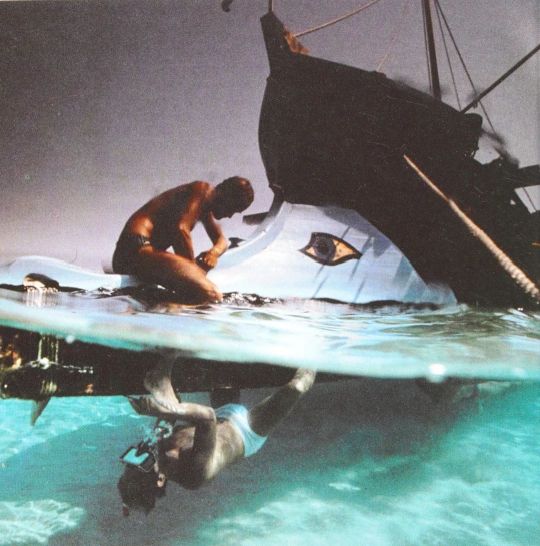
Argo's crew cleaning the hull of the galley in the clear waters of Oxbelly Bay, in the Peloponese, 1984. Photo by Kevin Flemming. "The voyage of Odysseus posed one of the most tantalising riddles in history: was Homer's Odyssey entirely imaginary? or did Ulysses make a real voyage home from the siege of Troy to Ithaca? Did Scylla and Charybdis and the Cyclops really exist in any form? Tim Severin uses his replica of a Bronze Age galley to follow the clues which lead to a startling solution to the puzzle. According to legend, Ulysses was nine years on his homeward journey, and over the centuries historians, classicists and archaeologists alike have tried to make sense of his wanderings. Every place that Homer mentions has been identified differently and no two investigators agree on all locations. Ulysses' logical homeward route has been put to the practical test in a faithful replica of the type of ship used in Ulysses' era, and sailed by the rules of navigation of the time. Tim Severin overturns all the orthodox theories, and in a remarkable series of discoveries charts the likely position of the Clashing Rocks, reveals where the cave of the legendary Cyclops would have been, and establishes the origins of Ulysses' adventures." From "The Ulysses voyage: sea search for the Odyssey" by Timothy Severin, 1987. https://www.instagram.com/p/CeZDU3nNB2d/?igshid=NGJjMDIxMWI=
102 notes
·
View notes